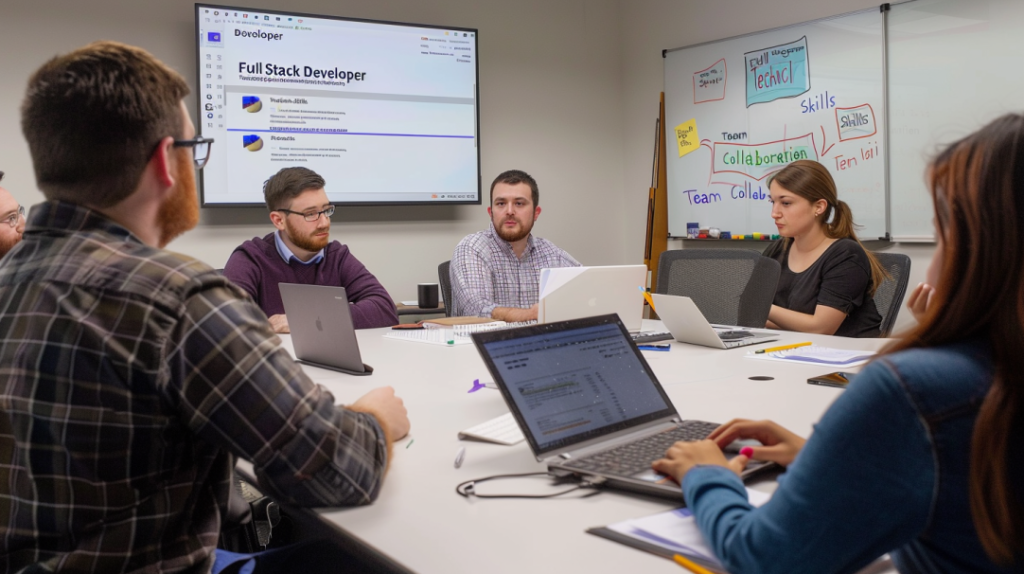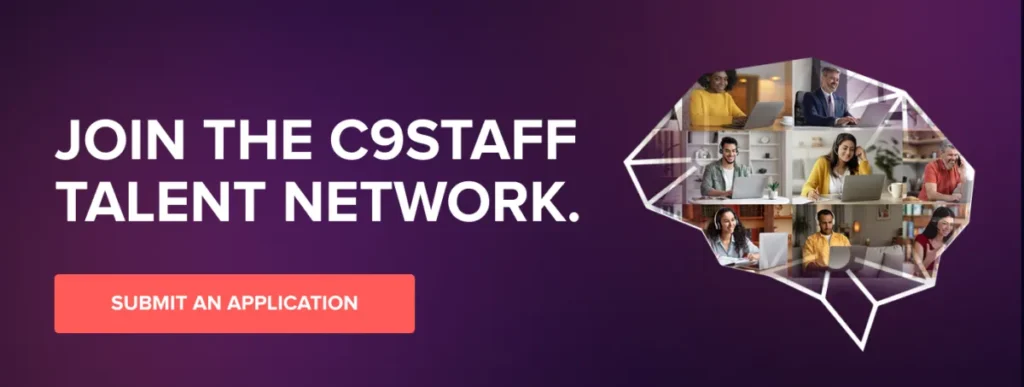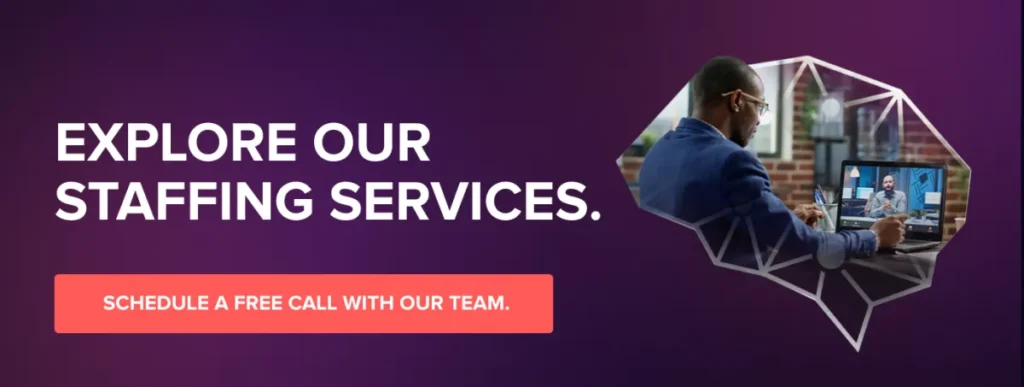Introduction

In today’s rapidly transforming digital landscape, the role of a full stack developer is more crucial than ever. Standing at the crossroads of technology and innovation, these professionals blend the mastery of front-end aesthetics with back-end functionality, embodying a synergy that drives modern web and application development. Full stack developers are not just jacks of all trades; they are seasoned navigators of user interfaces and the underlying engines of web technology, skilled in languages from JavaScript and Python to frameworks like React and Node.js. Their versatility makes them invaluable assets in building robust, scalable digital products that excel in both performance and user experience.
Employers looking for the ultimate job description template need look no further. If your goal is to draft a precise and compelling job description for a Full Stack Developer, our complimentary document is the resource you need. Crafted with the expertise of C9Staff’s top hiring practices and fundamental principles, this template serves as an exemplary foundation for defining your hiring specifications. Download it directly and start building your team with precision.
FULL STACK DEVELOPER JOB DESCRIPTION TEMPLATE

This article serves a dual purpose: For employers, it’s a toolkit for crafting precise and compelling job descriptions that resonate with the essence of what a full stack developer brings to the table. For candidates, it’s a navigator through the maze of job listings, helping align their skills and expectations with the real demands of the market. Whether you are looking to hire a developer who can pivot between multiple stacks or you are a developer aiming to position yourself effectively in a competitive job market, understanding these dynamics is key.
According to a recent report by the Bureau of Labor Statistics, demand for full stack developers is expected to grow by 27% by 2024, significantly faster than the average for all occupations. This statistic underscores the critical need for businesses to harness the full spectrum of web development capabilities to stay ahead in the digital curve. As Satya Nadella, CEO of Microsoft, puts it, “Bringing together the best of web development into integrated, multidisciplinary teams is not just a trend but a clear dictum for success in disruptive times.”
As we dig deeper into what makes a full stack developer truly integral to the tech ecosystem, let this guide empower both the employers crafting the job calls and the candidates responding to them, ensuring a match that not only meets but exceeds the evolving demands of the tech industry.
Master Full Stack Development in 2024: The Ultimate Guide to Success
What is a Full Stack Developer?

Visualize you’re boarding on a journey to become a full stack developer, a role that stands as the backbone of the tech industry, crafting seamless digital experiences from start to finish. A full stack developer is a technologist who is proficient in handling both the front-end and back-end portions of web applications. This means they work on everything from the user interface and user experience design on the front end to server, application, and database management systems on the back end. By bridging these two worlds, they create cohesive and fully functioning web applications that are as functional as they are appealing.
Essential Skills of a Full Stack Developer
To excel in this dynamic role, a full stack developer must cultivate a robust set of skills:
Technical Skills:
Front-end Technologies: Proficiency in HTML, CSS, and JavaScript, along with frameworks like React or Angular, enables developers to build intuitive user interfaces that engage and retain users.
Back-end Technologies: Knowledge of server-side languages such as Python, Ruby, and Java, and an understanding of server, network, and hosting environments, ensure that the applications run smoothly and securely.
Database Management: Skills in SQL or NoSQL database management are crucial for storing, retrieving, and managing data efficiently.
Soft Skills:
Problem-Solving: The essence of development work is solving problems. Whether debugging code, optimizing database queries, or ensuring user-friendly design, problem-solving is central to every task.
Teamwork: Full stack developers often lead projects or collaborate with other developers, designers, and stakeholders, making teamwork a vital skill.
Effective Communication: Articulating complex technical issues to non-technical team members or explaining project needs to clients are regular duties of a full stack developer.
Technological Proficiencies
Deep diving into the tools and technologies, a full stack developer’s toolbox is expansive:
Languages: Mastery over languages like JavaScript for front-end and Python or Ruby for back-end tasks.
Frameworks: Frameworks such as React for front-end development and Node.js for back-end operations facilitate efficient, scalable application development.
Real-World Application: For instance, using React to build a dynamic user interface for an e-commerce site, combined with Python-powered back-end, ensures both the smooth handling of transactions and an engaging shopping experience.
This overview not only educates aspiring developers about the integral role of a full stack developer but also sheds light on the blend of creativity and technical rigor required to excel in this field. Whether you’re aiming to hire a developer or become one, understanding these facets will prepare you for the challenges and rewards of this essential tech industry role.
Programming Future: Top Languages to Master in 2024
Writing a Job Description: Employer’s Guide

As an employer, the clarity and detail of your job descriptions play a pivotal role in attracting the best full stack developer talent. A well-drafted job description does more than list expectations; it acts as a strategic tool to draw in the right candidates and set them up for success within your organization. It should be clear, comprehensive, and compelling, setting the tone for the role and the relationship between the candidate and your company.
Key Components of a Full Stack Developer Job Description
Job Title: The job title should be precise and reflective of the role. Instead of just “Developer,” specify “Full Stack Developer” to immediately clarify the nature of the position. This small detail helps to attract applications from professionals who are specifically skilled in both front-end and back-end technologies.
Position Overview: This section should succinctly summarize the role’s main purpose and its importance within your organization. For example, “As a Full Stack Developer, you will bridge our front-end and back-end operations, contributing to the development of end-to-end solutions for our digital products.”
Specific Duties: List the typical responsibilities, such as “Develop client-side architecture using HTML/CSS/JavaScript,” “Create and maintain server-side applications,” and “Ensure responsiveness of applications.” Tailor this section to reflect the unique aspects of the job and the specific projects they will be working on.
Required Skills: Clearly delineate the technical skills and soft skills required. Technical skills might include “Proficiency in JavaScript, Python, and SQL,” while soft skills could encompass “Excellent problem-solving skills and ability to work in a team.” Ensure these requirements align with those outlined in the previous section of your article.
Qualifications: Specify the educational background and professional certifications ideal for a candidate, such as “Bachelor’s degree in Computer Science or similar field” and “Certifications in Node.js or React preferred.”
Benefits: Clearly present the benefits and perks of the position, which could include “Competitive salary, health insurance, and a flexible working environment,” as well as “Opportunities for professional development and certification.”
By following these guidelines and using the provided example as a blueprint, you can create effective and attractive job descriptions that not only draw in the best talent but also clearly communicate the opportunities and expectations associated with the role. This approach not only fills the position but also contributes to the long-term success of both the employee and your organization.
Employers looking for the ultimate job description template need look no further. If your goal is to draft a precise and compelling job description for a Full Stack Developer, our complimentary document is the resource you need. Crafted with the expertise of C9Staff’s top hiring practices and fundamental principles, this template serves as an exemplary foundation for defining your hiring specifications. Download it directly and start building your team with precision.
FULL STACK DEVELOPER JOB DESCRIPTION TEMPLATE

Analyzing Job Descriptions: Candidate’s Guide

As a full stack developer in the hunt for new career opportunities, you’re likely to encounter a variety of job descriptions daily. Each description presents a gateway to a potential job, but deciphering which ones align best with your skills and career aspirations can be daunting. This guide is tailored to help you, the job seeker, effectively analyze job descriptions to maximize both your job search and application success.
Understanding Job Descriptions
The first step in your job search is to read job descriptions meticulously. Focus on identifying key requirements such as essential skills, preferred experiences, and educational qualifications. Pay attention to the language used; it often indicates the company culture and priorities. Here are some tips for spotting red flags:
Vague Wording: Be wary of descriptions that are not clear about the job duties or expectations.
Unrealistic Expectations: Job listings that require a vast array of skills for a position that typically would not require them might indicate a misunderstanding of the role or poor management expectations.
Lack of Role Clarity: If the description does not clearly define what your day-to-day responsibilities will be, it might be a sign of disorganized operations.
Skill Gap Analysis
Once you have a clear understanding of the job’s requirements, compare these against your current skill set. This is how you perform a skill gap analysis:
List the Required Skills: Write down all the technical and soft skills the job description mentions.
Mark Your Proficiencies: Tick off the skills you already possess.
Identify Learning Opportunities: Note any skills you lack, which could become targets for your professional development.
This analysis not only helps tailor your job applications but also guides your ongoing learning endeavors, ensuring you remain competitive in the job market.
Tailoring Your Application
To increase your chances of landing an interview, customize your resume and cover letter for each application:
Echo the Job Post Language: Use key phrases and terms from the job description in your application. This demonstrates that your skills and experiences align with what the employer is seeking.
Highlight Relevant Experience: Draw direct connections between your past job duties and the responsibilities listed in the job description.
Showcase Your Skills: Make sure to clearly list any exact skills mentioned in the job post, particularly those that are directly related to the tasks you’ll be expected to perform.
Long-Term Career Planning
Use the insights gained from analyzing job descriptions not only to apply for current positions but also for your long-term career planning. This analytical approach can inform your decisions about what new technologies to learn, which certifications might be beneficial, and how to strategically develop your career path in full stack development.
Remember, the ability to critically assess job descriptions is a powerful tool in your career development arsenal. It helps you apply strategically, learn continuously, and plan thoughtfully, keeping you ahead in the ever-evolving tech landscape.
If you’re ready to supercharge your career and land your dream job, C9Staff is here to help you make that leap. By clicking the link below, you can submit your resume to our talent acquisition department. If your qualifications align with our client requirements, we will contact you to discuss potential opportunities that match your skills and aspirations. Don’t miss the chance to take your professional journey to the next level.

The Hiring Process from Both Sides

Navigating the hiring process can be a daunting endeavor, whether you are the hiring manager at a tech company or a candidate applying for a full stack developer position. This section provides insights and strategies from both perspectives, ensuring effective preparation and successful outcomes.
For Employers: Best Practices in Screening and Interviewing Candidates
The foundation of a successful hiring process is a structured screening protocol. As an employer, it’s crucial to establish specific criteria derived directly from the job description. This ensures that the candidates who progress to the interview stage have already met the essential qualifications and skills necessary for the role.
When conducting interviews, focus on a mix of behavioral and technical questions. Behavioral questions help you understand how the candidate has handled past situations and whether they align with your company’s culture. Technical questions, on the other hand, assess their proficiency in necessary skills like JavaScript, React, or Node.js. For decision-making, consider using collaborative evaluation techniques involving multiple team members or scoring systems to maintain objectivity.
For Candidates: Insights into What Employers are Looking For During Interviews
If you are a candidate, understanding what happens during the interview process can significantly enhance your preparation. Expect to face questions that not only test your technical abilities but also explore your problem-solving strategies and adaptability. Prepare for different interview phases—from initial phone screenings focusing on your background and soft skills to technical assessments that may involve coding challenges or portfolio reviews.
Soft skills like effective communication, teamwork, and a proactive attitude are invaluable. During your interview, demonstrate these skills by sharing specific examples from your past experiences that showcase your ability to work well in team settings and overcome challenges.
Career Path and Advancement

As a full stack developer, whether you’re just beginning your career or seeking ways to advance, understanding the potential career trajectories and growth opportunities in this field is crucial. This guide will help you navigate the evolving landscape of full stack development and identify the paths that can lead to fulfilling career progressions.
Career Trajectory for Full Stack Developers
Entry-Level to Senior Positions: Your journey might start as a Junior Developer, where you’ll cut your teeth on both front-end and back-end technologies, learning to integrate them into complete applications. As you gain experience, you could progress to a Mid-Level Developer, taking on more complex projects. Ultimately, you could ascend to a Senior Developer role, where strategic thinking and high-level decision-making are part of your daily routine. Senior roles often evolve into Lead Developer positions, where leadership and mentoring become key components of your responsibilities.
Specialization Opportunities: Throughout your career, you may choose to specialize in areas that particularly interest you. For instance, you might focus on advanced backend technologies like sophisticated database management systems or blockchain technology. Alternatively, you could steer towards project management, helping coordinate teams and projects to ensure timely delivery of software solutions.
Leadership Roles: For those with a knack for leadership and strategic vision, moving into supervisory or managerial roles is a natural progression. These positions could eventually lead to executive roles such as Chief Technology Officer (CTO) or even preparing you to launch your own tech startup.
Continuing Education and Certifications
Essential Certifications: Enhancing your qualifications through certifications can significantly boost your career. For example, obtaining the AWS Certified Solutions Architect certification can be beneficial if you’re involved in cloud-based projects. Similarly, a Project Management Professional (PMP) certification could be valuable if you’re moving into project management roles.
Lifelong Learning: The tech field is constantly evolving, and staying abreast of the latest technologies, frameworks, and best practices is imperative. Engage with platforms like Udemy, Coursera, or niche-specific bootcamps to keep your skills sharp and relevant. Continuous learning is not just about staying current; it’s about staying competitive.
Networking and Community Involvement: Active participation in tech meetups, conferences, and online forums not only helps you stay informed about the latest industry trends but also opens doors to mentorship opportunities and potential job offers. Building a robust professional network can be as crucial as building robust code.
Industry Trends Impacting Full Stack Developers
As a full stack developer or an employer within the tech industry, staying abreast of the latest technologies and methodologies is crucial to maintaining a competitive edge. This section offers you a glimpse into the evolving landscape of full stack development, highlighting emerging technologies, the latest methodologies, and job market trends that could shape your career or business strategies.
Latest Technologies
Emerging Technologies: Artificial Intelligence (AI) and Machine Learning (ML) are revolutionizing the way we approach full stack development. Integrating AI into web applications can enhance user experience through personalized content, predictive behaviors, and intelligent automation. As a developer, mastering these technologies can set you apart in the job market.
Methodologies: The adoption of DevOps practices and agile methodologies continues to grow, emphasizing the importance of continuous integration and continuous delivery (CI/CD). These practices not only streamline development processes but also foster a culture of collaboration and immediate feedback, essential for rapid deployment cycles.
Tools and Frameworks: The shift towards serverless architectures and the use of containerization tools like Docker simplifies deployment and scalability. Meanwhile, frontend frameworks like Vue.js are becoming popular for their simplicity and ease of integration, offering robust alternatives to more established frameworks like React and Angular.
The Future Job Market
Demand Trends: The demand for skilled full stack developers is projected to rise significantly, driven by digital transformations across various industries and the growing prevalence of remote work models. Companies are looking for developers who can manage both client and server software, making full stack skills increasingly valuable.
Skill Requirements: As technology evolves, so too do the skills required to remain relevant. Upcoming trends suggest a growing need for developers who are proficient in cloud technologies, cybersecurity, and cross-platform development. Staying updated with these skills is imperative to maintaining a competitive edge.
Opportunities and Challenges: With the rise of IoT and mobile applications, opportunities in emerging markets are expanding. However, these opportunities come with challenges such as the need for continuous learning and adaptation to keep pace with rapidly advancing technologies.
Employers seeking to enhance their team with top-tier Full Stack Developer talent are invited to discover how C9Staff can streamline your hiring process. By clicking the link below, you can schedule a complimentary exploratory call with one of our knowledgeable account managers today. During this call, we will attentively listen to your specific needs and recommend potential candidates at no cost, allowing you to evaluate the best talent available at competitive prices. Don’t miss this opportunity to optimize your recruitment strategy.

Conclusion
As we wrap up this comprehensive exploration into the world of full stack development, let’s recap the vital insights and actionable advice that we’ve covered. From the multifaceted role of a full stack developer to the intricacies of crafting and analyzing effective job descriptions, and the best practices for navigating the hiring process, this guide has equipped both employers and candidates with the essential knowledge needed to succeed in today’s tech-driven market.
We dug into the career trajectory for full stack developers, highlighting the promising opportunities for growth and advancement through continuous education and specialization. Moreover, we explored the latest industry trends, such as the increasing integration of AI and machine learning into development tasks, and how these trends are shaping the future job market.
As both an employer and a candidate in the tech industry, embracing the continuous evolution of the full stack developer role is crucial. The tech landscape is perpetually in flux, and adaptability, coupled with proactive learning, are your best tools for staying relevant and competitive. Whether you’re hiring the next innovator or stepping up to become one, remember that the journey of education and adaptation never truly ends.
Now, I turn the conversation over to you. Share your experiences, questions, or insights on full stack development in the comments below. Your contributions not only enrich this discussion but also foster a community of learning and growth. Additionally, if you found value in this guide, please share it within your networks to help others navigate the dynamic world of full stack development.
Together, let’s continue to learn, adapt, and thrive in the ever-evolving tech industry.




